Labels Dashboard
Chellie Esters
Caroline Antoun
The Labels dashboard details the work orders and invoices for which you have applied a Label.
You can download the data and email reports to recipients.
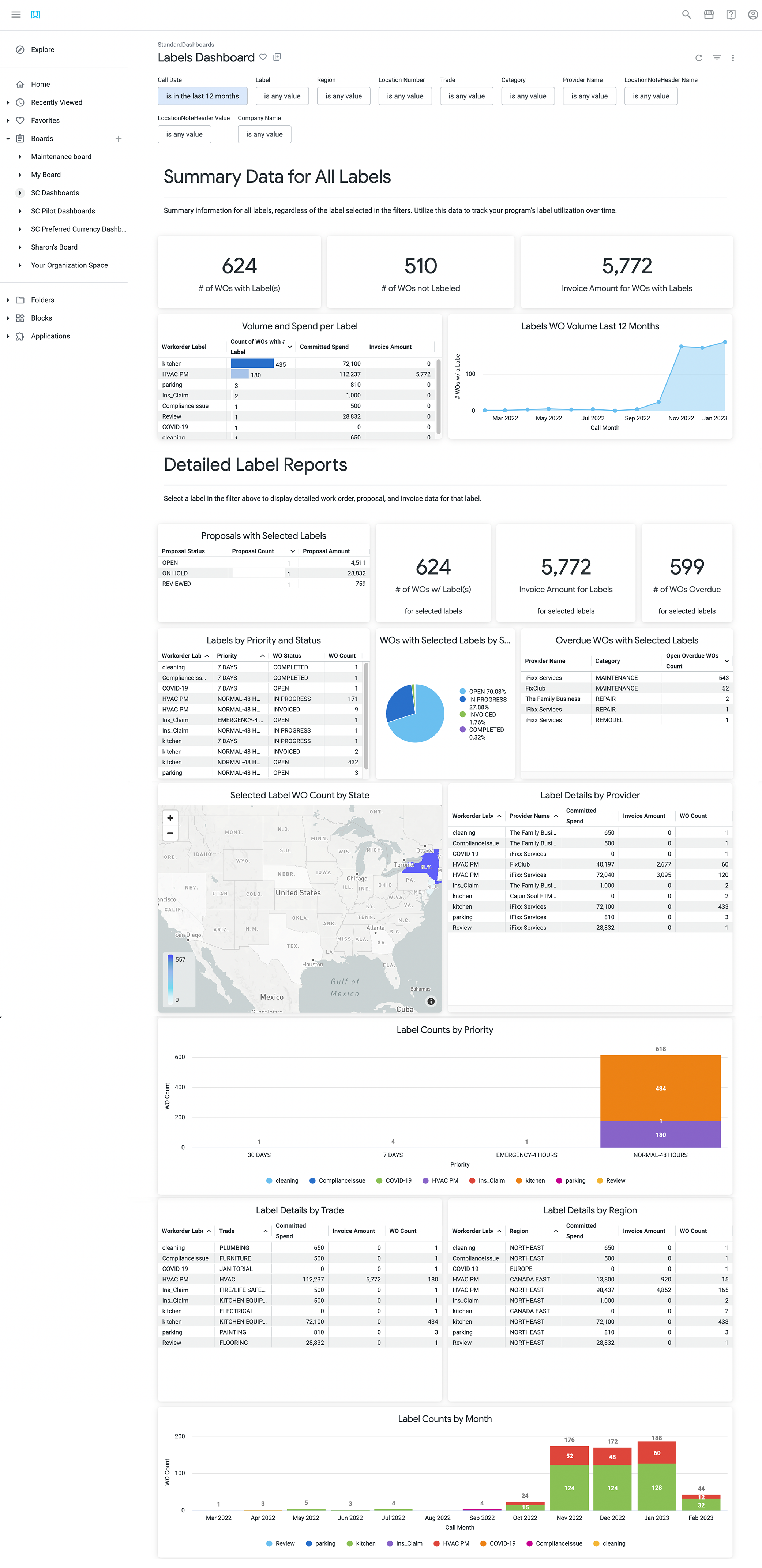
Visualizations in this Dashboard
There are two sections, with multiple visualizations under each:
- Summary Data for All Labels gives a headline view of all work orders with and without labels, the total invoice amount for work orders with labels, and monthly work order volume for those with labels assigned.
- Detailed Label Reports breaks down labeled work orders and invoices by facilities spend, status, overdue work orders, priority, provider, trade, and region.
The Summary Data will always show all work orders and Label data, regardless of any filters applied.
The Detailed Label Report shows all data by default. Use the all-inclusive filters along the top of the report to hone in on a specific Label or group of Labels, or to focus on specific Trades, Categories, Location information (Region or specific Location), or Provider.
Summary Data for All Labels

These headlines tiles give you an overall view of the work orders and invoice amount for tagged work orders. Here you will find:
- The number of work orders with at least one Label
- The number of work orders not Labeled
- The total Invoice Amount for all work orders with Labels
- The volume of all Labeled work orders over the past 12 months.
Click into each visualization to view the underlying data, such as tracking numbers, work order details, assigned providers, and committed spend. Click the tracking number to navigate to the work order details in Service Automation.
Detailed Label Reports
In this section, Labeled Work Orders and Invoices are dissected into an array of metrics to help you manage those tagged for events, inspections, or other internal reasons. Again, to see data for specific Labels, use the all-inclusive filters along the top of the report.
Label Volume and Spend, Invoices Amounts, Work Order Details, and Overdue Work Orders
This area summarizes facilities spend by Label so you can monitor the volume of work orders and spend by tagged events. Here you will see the following visualizations:
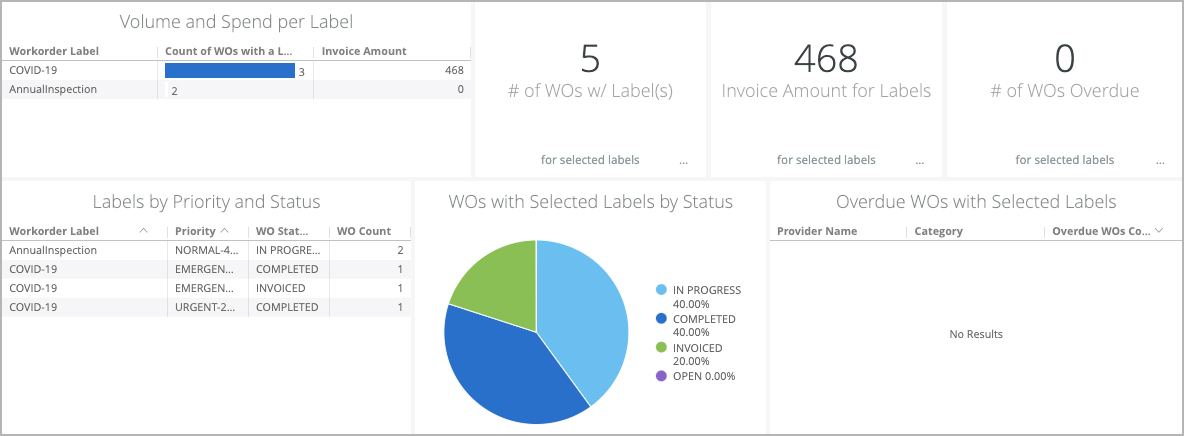
- Volume and Spend per Label
- # of WOs w/ Label(s)
- Invoice Amount for Labels
- # of WOs Overdue
- Labels by Priority and Status
- WOs with Selected Labels by Status
- Overdue WOs with Selected Labels
Selected Label WO Count by State
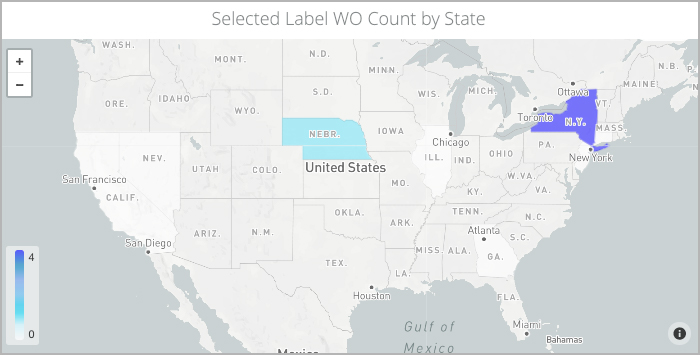
This visualization geographically highlights which states and countries have at least one work order with at least one Label assigned to it. States and Countries with such Labels are colored: the darker the color, the higher the volume of Labels on work orders for that state or country.
Hover over each state or country to view the total number of Work Orders with Labels. Click each total to view the underlying data, such as tracking numbers, work order details, assigned providers, and committed spend. Click the tracking number to navigate to the work order details in Service Automation.
Label Details by Provider

This table lists each work order label/service provider combination, as well as the committed spend for the total volume of work orders.
In the above illustration, FixxBandits has 2 work orders assigned with the Label "COVID-19." The Total NTE Amount for those 2 work orders is 1,500 and the total Invoice Amount is 468. The next COVID-19 line item is for FixxBandits.
This table helps you see the allocation of work orders with specific labels to certain Providers. To focus on the committed spend across all Labels for a specific Provider, use the all-inclusive filters along the top of the report.
Clicking any of the amounts drills down into the underlying data, where you can see the related tracking numbers, work order details, assigned providers, and committed spend. Click the tracking number to navigate to the work order details in Service Automation.
Label Counts by Priority

This stacked bar breaks down Labels by work order Priority. You will see the number of Labeled work orders with the same Priority stacked one on top of the other, with the total along the top of each bar.
Clicking any of the bars drills down into the underlying data, where you can see the related tracking numbers, work order details, assigned providers, and committed spend. Click the tracking number to navigate to the work order details in Service Automation.
Label Details by Trade and Label Details by Region

Both tables summarize the committed spend per work order volume for work orders, either by Trade or by Region.
Using this table, you can see the allocation of work orders with specific labels to certain Trades and Regions. To focus on the committed spend across all Labels for a specific Trade or Provider, use the all-inclusive filters along the top of the report.
Clicking any of the amounts drills down into the underlying data, where you can see the related tracking numbers, work order details, assigned providers, and committed spend. Click the tracking number to navigate to the work order details in Service Automation.
Label Counts by Month

This visualization stacks the total number of Labeled work orders for each month. Similar to the Priorities stacked chart, you will see the number of Labeled work orders for each given month stacked one on top of the other, with the total along the top of each bar.
Clicking any of the bars drills down into the underlying data, where you can see the related tracking numbers, work order details, assigned providers, and committed spend. Click the tracking number to navigate to the work order details in Service Automation.
Commonly Used Features
Below is a quick reference guide regarding tracking numbers in Analytics, filtering, sorting, downloading data, and sending reports.
Tracking Numbers in Analytics
Throughout Analytics you can drill down into visualizations to see the underlying data. In most cases, the tracking numbers related to that data are listed. You can click the tracking number to navigate straight to the work order details in Service Automation.
Filtering Dashboards
On top of the report are all-inclusive filters to help you hone in on key data. All reports on the page are affected by the criteria set in these all-inclusive filters.
The filter criteria for each dashboard may differ. Filters reset to the default when the page is refreshed.
Click filter field to show the criteria.

Select the desired criteria to include or exclude:
To Include criteria: select is equal to, contains, starts with, or ends with, and then begin typing the criteria in the picklist. Select the desired criteria (or multiple criteria) from the picklist.
To exclude criteria: select is not equal to, does not contain, does not start with, or does not end with.
Is null depicts the absence of data in a data set. Conversely, is not null depicts the presence of data
To include or exclude data without a certain data criteria — for example, to select data without a Region or District assigned in Service Automation — choose is blank / is not blank.
To add more options, click the plus sign (+) next to a field to add another option to the filter. The new option will appear as either an OR condition or an AND condition, depending on the type of filter option.
Once all criteria are selected, click Refresh icon in the top-right corner. The Dashboard report updates with the selected criteria.
More details are available on Filtering an Analytics Dashboard
Dynamic Table Sorting
Analytics tables are dynamic, as you can:
- click column and row headers to sort data (the arrow indicate which data is sorted),
- hover over a header to show the gear icon where you can interact with the data more dynamically, and
- drag and drop a header to rearrange the table.
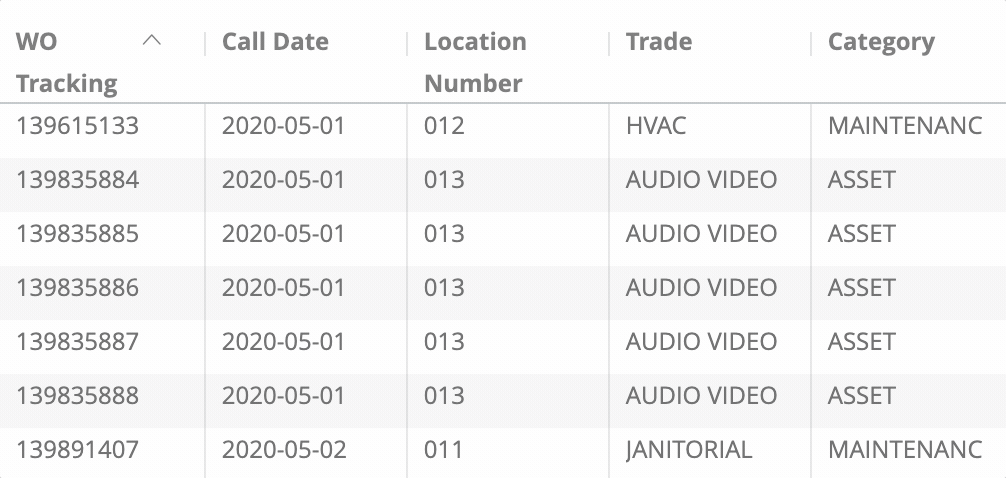
Downloading and Sending Reports
In the upper-right corner of any page, click the Vertical Ellipses to download reports, schedule delivery of reports at regular intervals, add to a board, or get a link.
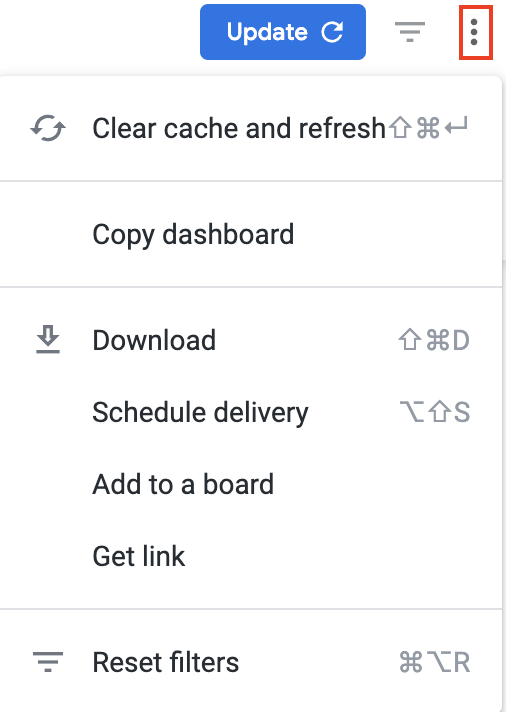
You can download data from a table and visualization or download a dashboard tabto PDF or CSV.
- On the desired table or visualization, hover over the upper-right to expose the 3 dots menu, and then click Download Data. The Download modal appears.

Select the desired File Format and choose a File Name: A default name is listed but you can change it.
- Click Download.
On the desired dashboard (or dashboard tab), click the Gear icon in the upper-right of the page, and then click Download as PDF. The Download modal appears.
A default Filename appears, but you can change it.
Under Advanced options:
Single-column format lays out all tables and visualizations on a page into one column in the PDF, as opposed to how it is laid out in the dashboard.
Expand tables shows all rows in a table, instead of just the rows that appear on the dashboard.
Paper size adjusts the PDF to your desired size.
Click Open in Browser to view the PDF in your chosen browser, or click Download to save a version of the report onto your device.
On the desired dashboard (or dashboard tab), click the Gear icon in the upper-right of the page, and then click Download as CSVs... A new browser tab opens.
After the files render, you are prompted to save the CSV Zip file onto your device.
More details are available on Downloading and Sending Dashboards and Reports
You can also Send a one-time report via email or Schedule a recurring email send.
On the desired dashboard (or dashboard tab), click the Gear icon in the upper-right of the page, and then click Send. The Send (Dashboard Name) modal opens.
A Title is given by default, but you can change it.
Under Who should it be emailed to?, enter the desired recipient(s), separated by a comma, and then click Add.
(Optional) Click Include a custom message to add a personal note.
Under Format data as, choose PDF, Visualization, or CSV Zip file.
(Optional): Click Filters to limit the criteria that appear in the email. Note that the same filters on the dashboard itself will also appear here.
Click Send. The email is sent to your recipients.
On the desired dashboard (or dashboard tab), click the Gear icon in the upper-right of the page, and then click Schedule. The Schedule (Dashboard Name) modal opens.
A Title is given by default, but you can change it.
Under Who should it be emailed to?, enter the desired recipient(s), separated by a comma, and then click Add.
(Optional) Click Include a custom message to add a personal note.
Under Format data as, choose PDF, Visualization, or CSV Zip file.
Under Deliver this schedule, choose Daily, Weekly, Monthly, Hourly, or By minute (in 5-minute increments, up to 30 minutes)
(Optional): Use Filters to limit the criteria that appear in the email. Note that the same filters on the dashboard itself will also appear here.
Click Send. The email is sent to your recipients.
More details are available on Downloading and Sending Dashboards and Reports
-
Page:
-
Page:
-
Page:
-
Page:
-
Page:
-
Page:
-
Page:
-
Page: